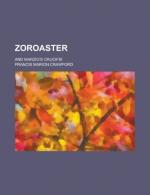For a new element had entered into the current of Zoroaster’s thoughts. For years he had seen the lovely child Nehushta growing up. As a boy of twenty summers he had rocked her on his knee; later he had taught her and played with her, and seen the little child turn to the slender girl, haughty and royal in her young ways, and dominating her playfellows as a little lioness might rule a herd of tamer creatures; and at last her sixteenth year had brought with it the bloom of early southern womanhood, and Zoroaster, laughing with her among the roses in the gardens, on a summer’s day, had felt his heart leap and sink within him, and his own fair cheek grow hot and cold for the ring of her voice and the touch of her soft hand.
He who knew so much of mankind, who had lived so long at the court, and had coldly studied every stage of human nature, where unbridled human nature ever ruled the hour, knew what he felt; and it was as though he had received a sharp wound that thrust him through, body and heart and soul, and cleft his cold pride in two. For days he wandered beneath the pines and the rhododendron trees alone, lamenting for the fabric of mighty philosophy he had built himself, in which no woman was ever to set foot; and which a woman’s hand, a woman’s eyes had shattered in a day. It seemed as if his whole life were blasted and destroyed, so that he was become even as other men, to suffer love and eat his heart out for a girl’s fair word. He would have escaped from meeting the dark young princess again; but one evening, as he stood alone upon the terrace of the gardens, sorrowing for the change in himself, she found him, and there they looked into each other’s eyes and saw a new light, and loved each other fiercely from that day, as only the untainted children of godlike races could love. But neither of them dared to tell the prophet, nor to let those of the palace know that they had pledged each other their troth, down there upon the moonlit terrace, behind the myrtles. Instinctively they dreaded lest the knowledge of their love should raise a storm of anger in Daniel’s breast at the idea that his chosen philosopher should abandon the paths of mystic learning and reduce himself to the level of common mankind by marriage; and Zoroaster guessed how painful to the true Israelite would be the thought that a daughter and a princess of Judah should be united in wedlock with one who, however noble and true and wise, was, after all, a stranger and an unbeliever. For Zoroaster, while devoting himself heart and soul to the study of Daniel’s philosophy, and of the wisdom the latter had acquired from the Chaldeans, had nevertheless firmly maintained his independence of thought. He was not an Israelite, nor would he ever wish to become one; but he was not an idolater nor a Magian, nor a follower of Gomata, the half-Indian Brahmin, who had endeavoured to pass himself off as Smerdis the son of Cyrus.




